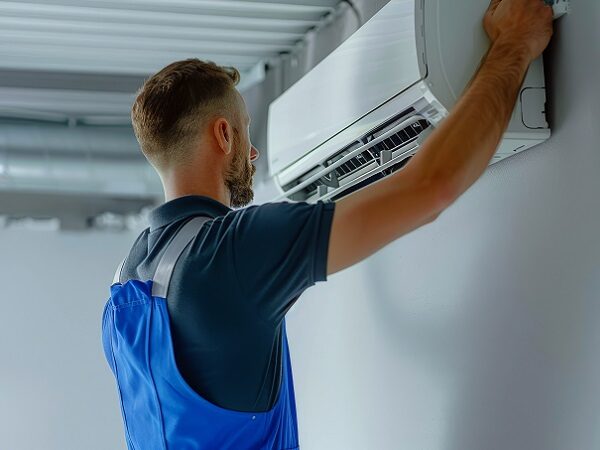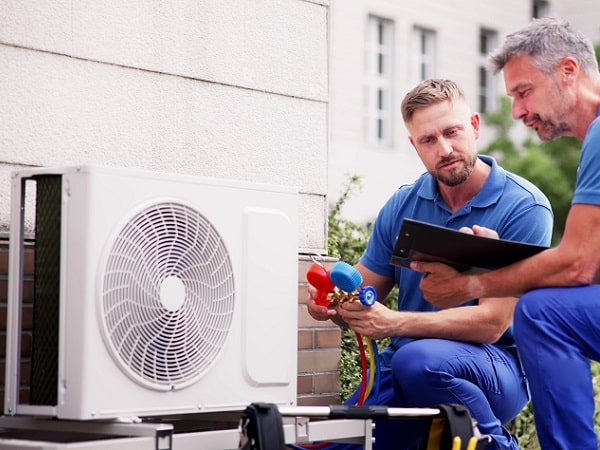The purpose of bringing clean air into the building is to dilute and remove humid air and provide sufficient air movement to give a feeling of freshness without causing a draught.
How Does Poor Office Ventilation Affect Health?
A lack of adequate ventilation in buildings can lead to a number of health problems for workers, including:
- Headaches
- Tiredness
- Itchy skin
- Eye irritation
- Blocked or runny nose
- Rashes
- SBS (Sick Building Syndrome) which can be a collection of the above symptoms – see the NHS Website: Sick Building Syndrome.
What Are the Legal Requirements for Office Ventilation?
Air Circulation in the Office
Employers in the UK are required to ensure that the amounts of fresh or purified air coming into the office or workplace are appropriate and will supply adequate oxygen and remove the right amounts of carbon dioxide. Employees should be provided with fresh air and ‘dirty’ or humid air should be removed.
Ventilation can be supplied through either natural or mechanical methods. In small offices or similar environments, windows may offer enough fresh air. However, for offices situated in larger office blocks, tower blocks, factories and warehouses, ventilation will usually need to be supplied via a HVAC system in order to bring sufficient clean air into the building and circulate it.
A company must also ensure that any odours from food or any excess contaminants such as dust and fumes are properly removed.
Temperature of the Office
In addition to ensuring an adequate flow of fresh air, workplaces are obligated to provide an environment with an appropriate temperature. Legislation covers both the supply of heat and the supply of air conditioning, depending on what is required. Yet, this requirement is somewhat complicated, as different people can experience different levels of comfort when working at the exact same temperature.
Guidelines suggest that workplaces where most of the work is done without physical effort, such as an office, should be kept at temperatures of at least 16°C, while work which requires a greater level of physical exertion should take place in an environment kept to at least 13°C. There are exceptions to this.
Of course, when it comes to temperature, office staff in the same room or building will have a wide range of ideas of how hot or cold the office should be!
Hot and Cold Environments
This doesn’t usually apply to offices, however it is worth noting that some occupations are exempt from temperature regulations as they require workers to spend significant time working in temperatures which are either higher or lower than the guidelines mentioned above. Examples of these jobs include work in kitchens, work in cold storage areas and work which takes place outside.
In such instances, employers are legally required to carry out a risk assessment and take steps to ensure that the physical well-being of employees is not compromised. This may include the installation of fans or heaters, the supply of suitable clothing for work in the environment in question, or the provision of regular breaks away from the environment.
Situations where these kinds of factors will need to be considered can include working in cold storage centres, food preparation e.g. kitchens, bakeries, foundries, launderettes etc. and adequate provisions will need to be put in place to eliminate or minimise the effects of working in extreme cold or heat.
Other Legal Requirements for Offices
The Control of Substances Hazardous to Health Regulations 1999 require employers to prevent and control exposure to harmful substances, using suitable measures, including providing appropriate ventilation.
The Workplace (Health, Safety and Welfare) Regulations 1992 also requires employers to:
- Keep mechanical ventilation systems in good working order, carrying out regular checks and repairs (regulation 5)
- Provide sufficient ventilation to prevent offensive toilet odours from lingering or drifting to the workplace, and provide protection for non-smokers from cigarette smoke (regulations 21 and 25)
The Health and Safety (Consultation with Employees) Regulations 1996 require employers to make information on their ventilation available to their workers.
Here at Atmostherm Ltd we design and install office ventilation systems, plus service and maintain existing systems, across Greater Manchester and the North West.



